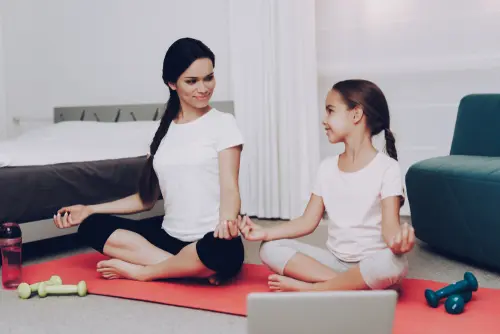
Jan 07, 2022 • 4 min read
How Yoga Is Beneficial for Sports & Recovery in Youth Athletes
Posted in:
Yoga is a fun, easy, and beneficial practice for young athletes. It builds core strength, improves balance and body awareness, and aids in recovery. Yoga helps athletes to notice the relationship between their mindset and their performance. It can be a great way to help an athlete get better at failing, and falling, in a safe space.
Improves balance
Sure, many natural athletes are born with good balance. Luckily, it’s a skill that can also be improved with practice. Many yoga poses involve standing on one foot or balancing your body weight on your hands or elbows. This can make kids quicker on their feet in the field or on the court.
Builds core strength
Many people strive for six-pack abs because it looks good. Yes, even kids. Yet, a strong core can help prevent injuries. Strong abdominal and back muscles also help to support good posture, which leads to a more regulated nervous system. This helps the brain to produce more feelings of peace and calm, which is a win for any athlete.
Increases body awareness
Yoga helps young athletes develop a better sense of where their body is in space. This allows them to have more control of how their body performs. Body awareness also helps in social situations. You don’t want your athletes to be that too-close talker or the clumsy kid.
Develops a mindset of trying new things
A yoga mat is a great place to practice failing. “Go to your edge, but no further,” is a phrase often heard in a yoga class. A student might fall in tree pose or tumble out of crow pose. That’s OK! By learning to try new things, kids discover that falling (or failing) is not the worst thing in the world. It’s a chance to get up and try again.
Yoga can help with recovery in young athletes
Many athletic injuries happen from repetitive motions in certain sports. The repetitive jumping, twisting and running motion of most sports can take its toll on the body. Yoga can strengthen muscles and relieve tension in injury-prone areas like the joints.
Four yoga poses to try with kids at home or at practice
Tree Pose
Often when you ask a young kid to do yoga, they will immediately do Tree Pose. It’s popular for good reason! Tree pose not only helps with balance, but it is a grounding pose. Grounding poses tend to give the person a sense of rootedness into the earth. They are great for kids who are nervous about an upcoming game or distracted by something else.
Plank Pose
Plank pose is a core-strengthening pose where one holds their body as straight and stiff as a plank of wood. It’s a simple pose that many kids naturally know how to do. Use subtle cues such as “don’t let your belly sag to the floor” to help with body awareness and getting good form.
Seated Twist
Twisting poses are great for the spine and help increase strength and mobility. Young athletes have to learn to listen to the instructions to perform twisting poses. It boosts focus and improves body awareness.
Crow Pose
Crow Pose actually looks a lot harder than it is. It’s a fun, challenging pose that relies more on physics than physical strength. It’s a great pose for kids to practice failing or laughing at themselves when they make a mistake. And it can be a confidence booster when a young athlete figures out how to do it.
Sarah Kostin is a freelance copywriter, published author, and former children’s librarian. With a background in yoga, mindfulness, life coaching, and ultramarathon running, Sarah has a passion for writing about fitness, mindset, personal growth, and overall well-being.

